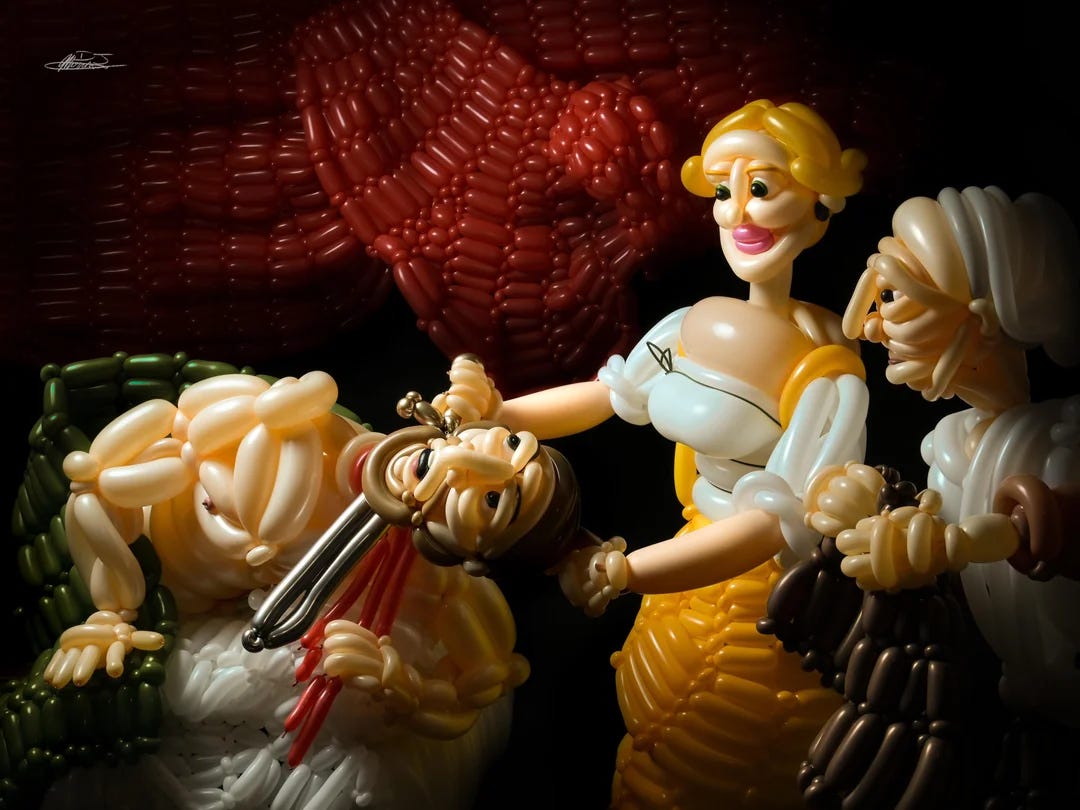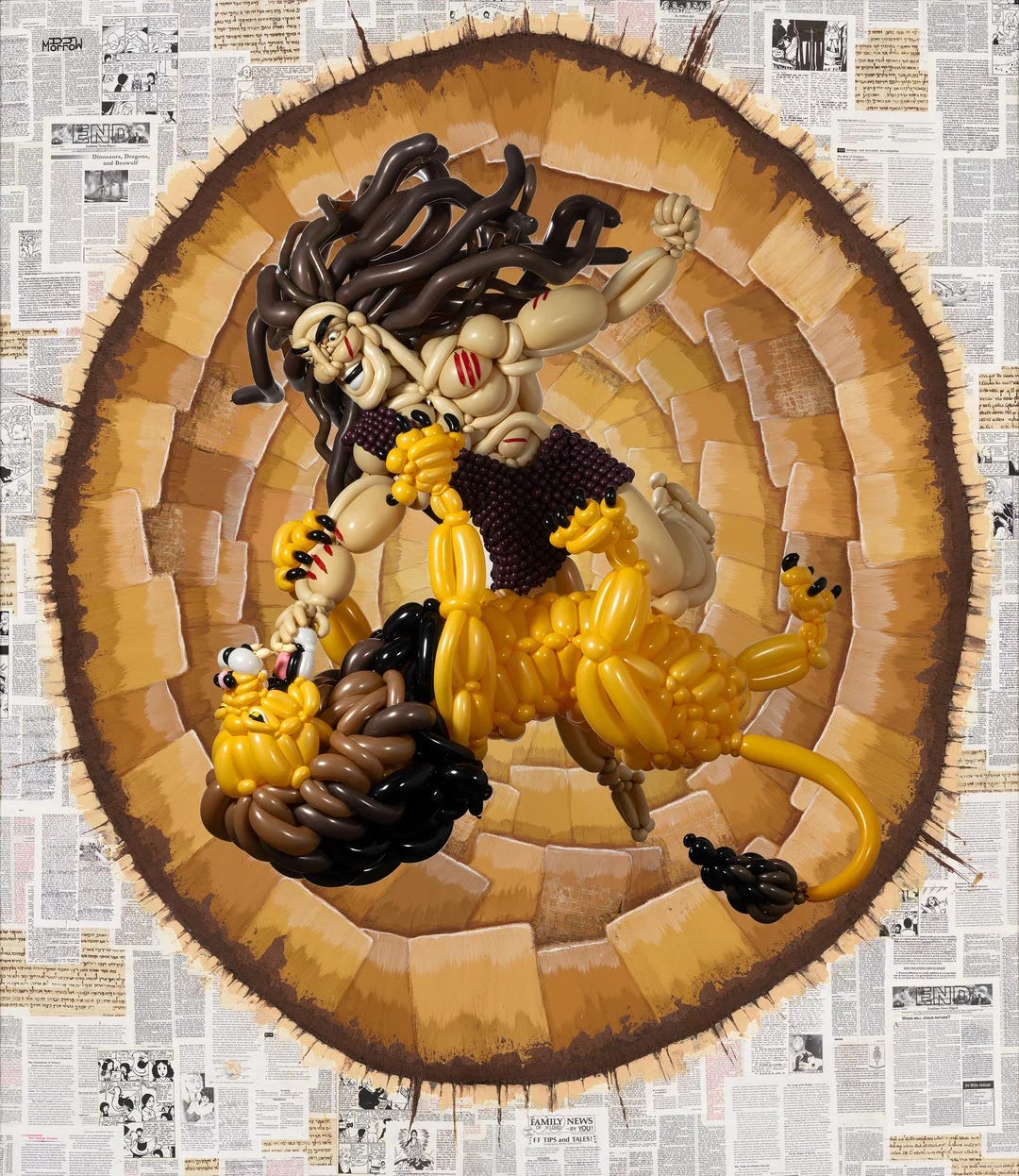Meet the Michelangelo of Balloons
An afternoon in Houston with outsider balloon artist DJ Morrow
It’s a hot sticky day in Houston, as most days are in July. Terrible weather for balloons. DJ Morrow is waiting for me on the far end of the parking lot in his condo development. Already a slight figure, Morrow first appears wavy in the heat haze, waving to me in the distance. As I approach, Morrow’s form reveals itself as a young bespectacled man with worried eyes. His long hair is pulled back into a pony tail and a disconnected goatee on his chin. He leads me up to the small apartment he shared with his partner, Misty, and hundreds, if not thousands, of balloons.
Morrow is perhaps the most famous avant-garde balloon twister in the world. Which is to say, Morrow is not very famous at all. His chosen medium – balloons -- is at once ephemeral and infantilized. Balloons are the province of the birthday party, or perhaps, the corporate meeting. They are for twisting into doggies and swords, boats and hats. But Morrow is up to something else. The first piece I had even seen of his was a recreation of Goya’s Saturn Devouring His Son, wrought in balloons. Other work includes a strangley joyful Judith with the head of Holofernes and a Francis Bacon inspired portrait of Clarence Thomas. When I visit, he is in the midst of preparing for his first gallery show, "Out of the Strong, Something Sweet,” to be held at the Jung Center. The exhibit’s title is a reference to Samson’s Riddle, and explores Morrow’s own strange biography.
DJ Morrow was born a balloon twister in Rio de Janeiro but raised largely in Taiwan. His parents were third-generation members of the Family International, a cult founded in Southern California in the 1960s but with outposts globally. Its founder, David Berg, known as Mo’ David or King David, is Morrow’s great-great grandfather. Both of Morrow’s parents were balloon twisters too, a skill taught widely among the cult’s at one time 10,000 members. As Morrow explains to me, “You weren’t allowed to have regular jobs, which were called systemite jobs, so things like busking and balloons were very common.” Morrow remembers his mother twisting balloons in 1999 for refugees in Taiwan after a 7.6 magnitude earthquake destroyed their homes.
Morrow started balloon twisting at age 16. By the time his family had left the cult and Morrow had settled in Houston. He had enough skills to entertain an endless parade of children but still balloons were more commerce than art. (His real passion was becoming a prog rock drummer.)
Morrow’s moment of awakening came through tragedy. In 2015, his older sister was killed in a traffic accident. By this time, says Morrow, he had lost his faith. Though his parents had left the cult, they hadn’t forsaken Jesus. Their son felt the loss of their daughter and his own apostacy meant he couldn’t openly mourn with them. Meanwhile Morrow spent his days twisting balloons. “It was difficult dealing with all that stuff,” he says, “because I was doing balloon twisting, , working with kids, making people smile. It was just physically and spiritually painful to put on that smiling face, to be that joy for people and to hide the pain inside.”
Inspired by the works of earlier balloon pionners like New Zealand’s Matt Falloon and Canada’s Rupert Appleseed, one lonely Valentine’s Day, Morrow began to experiment with larger sculptures. He created “The Entertainer” a large scultpure half-Pagliacci half-Emmett Kelly. That figure, a sad clown, quickly went viral on Reddit. In it pathos and bathos collide, it’s both ridiculous and touching. Ridiculous and touching, nothing could have been more apt in 2020.
Since then, Morrow has continued to create large balloon sculptures in his living room. When I visit, elements for his first show occupy one half of the space. A large painting made up of Mo Letters, missives that David Berg sent his followers, leans against a wall. Peering closely I see a lion-headed headed repeated again and again. “For most of his life,” explains Morrow, “my great-great grandfather was portrayed as a lion, especially when he was in hiding.” The exhibit is all about wringing from trauma and tragedy something beautiful. According to Morrow, the show “depicts my struggle with the isolation and alienation of being brought up home-schooled with an ideology of elitist separation from the world, and the struggle to break down the barriers that resulted from that.” When the piece goes on display, the painting will be the backdrop of a life-size tableau of Samson slaying a lion made of balloons.
Like many artists, Morrow has a day job. (The drumming didn’t work out.) He is Houston’s premiere videographer for Indian and Pakistani weddings. And for the time being, it seems, he’ll have to continue his art as an avocation. Balloon art has two avenues of commercial viability: balloon twisting and balloon decor. One is for parties; the other for offices. Morrow is interested, on the other hand, in balloons as fine art, that is, balloons as a medium with a capacity to express the full range of the human experience: joy, sadness, love, alienation, redemption.
“Balloons are laden not only with heavy implications of peoples’ emotions and life experiences but with their own physical nature.” Especially in Houston heat, balloons are temporary. Morrow’s sculptures have maybe a 3-5 day window of peak form. Then they begin to lose their shine, to gradually lose air, to dull, soften and sag like a human body. Soon, they return to their natural uninflated state. Not that art must last forever. In that way, Morrow’s work brings to mine Jacque Tinguely’s self-destructing sculptures or, more recently, Banksy’s self-shredding painting. A more 1:1 comparison might be Jeff Koons’ oversized balloon dogs but Morrow’s work is much more interesting. Whereas Koons renders the impermanent everlasting, Morrow is concerned with depicting eternal themes in an ephemeral medium. Of course, one approach is much more commercial than the other. But, to my mind, Morrow, working at the outlands of the art world in a marginal medium is a much more brave artist. Balloons might not be forever but glory is.





